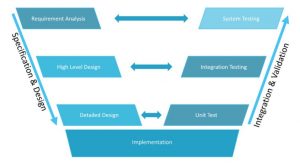Lesson 1 – Background of product design and validation process
Introduction:
- Modern industrial entities are characterized by their large scale and global production of standardized components, equipment, and software.
- The diverse stages in the value creation process have evolved to be optimized individually.
Segmentation of Value Creation Process:
- Design of Product: The initial step where a product’s blueprint is conceived.
- Production: The actual making of the product based on the design.
- Validation: Ensuring the product aligns with its intended function and meets specified standards.
Need for Process Guidelines:
- With global dispersion, the industry introduced structured instructions and guidelines.
- These guidelines streamline operations, elevate the success rate, and curb developmental expenses.
- Among these, the V-Model stands prominent and is widely adopted.
Deep Dive: The V-Model:
- Visual Representation: Picture the letter “V”. On the left are requirements, and on the right, the development stages with associated tests.
- Objective:
- Ensure the product aligns with the stipulated requirement.
- Guarantee that the development process is apt and adheres to stipulated norms.
- Validation and Verification: Two pivotal pillars of the V-Model.
- Validation: Does the product align with its real-life application?
- Verification: Is the product developed correctly in line with legislation, company norms, and standards?
User Requirements Specification (URS):
- A pivotal document that captures:
- The product’s purpose.
- How the product will achieve its purpose.
- Sources of requirements:
- End-users, e.g., a vehicle’s driver.
- Legal directives, like regional safety standards.
Validation and its Importance:
- Each stipulated requirement must correspond to a specific test.
- The test determines if the product aligns with the stipulated requirement.
- The rigor of these tests and the validation process depends on the industrial segment.
Automotive Industry Insight:
- Has a regimented validation process governed by industry standards.
- Some standards are legally binding while others are recommendations.
Beyond the Basics – Electric Drives:
- Electric drives are more than just fulfilling legal and user requirements.
- They present a window into myriad fascinating physical occurrences.
- Within an electric drive system, almost every field of physics is crucial, complemented by software and control design.
Conclusion:
- The V-Model, through its structured approach, ensures products are developed to be in sync with both their intended purpose and the process’s correctness.
- Standards and guidelines, while serving as a blueprint, also pave the way for fascinating innovations in fields like electric drives.

Figure The V-model